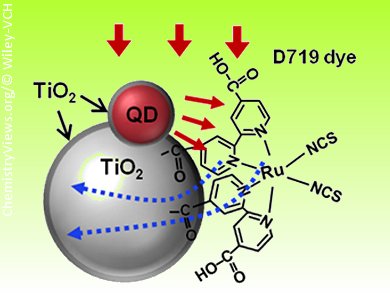Practical applications of dye-sensitized solar cells (DSSCs) require efficient light harvesting and high conversion efficiency across the full solar spectrum. Recently, Förster resonance energy transfer (FRET) has been studied as a promising method for achieving effectiveness over a broad spectral range. FRET is based on dipole–dipole coupling between chromophores, in which one molecule transfers its excitation energy nonradiatively to another separated by a short distance. Quantum dots (QDs) often have high molar extinction coefficients and broad absorption spectra in the visible region and thus are good candidates as donors in FRET-based DSSCs with dyes that absorb in the near-IR region.
Unfortunately, these systems often have low power-conversion efficiencies (>3 %) and involve a limited choice of dyes. In addition, dyes currently synthesized for FRET systems have limited incident-photon-to-current efficiency (IPCE; less than approximately 40 %).
J. Jang and co-workers, Seoul National University, Korea, have developed a simple and novel strategy to fabricate high-performance FRET-based DSSCs by the optimized design of a QD donor and a dye acceptor. The combination of QD (green) and dye D719 resulted in a large degree of overlap between the donor fluorescence spectrum and the acceptor absorbance spectrum, which enabled efficient FRET interaction between the constituents of the light-absorbing layer. This optimized FRET design provided 14 % enhanced power conversion efficiency and an excellent solar response over a wide wavelength range relative to pristine DSSCs.
- High-Performance Förster Resonance Energy Transfer (FRET)-Based Dye-Sensitized Solar Cells: Rational Design of Quantum Dots for Wide Solar-Spectrum Utilization,
E. Lee, C. Kim, J. Jang,
Chem. Eur. J. 2013.
DOI: 10.1002/chem.201300953




